How a Simmental herd made £79 a cow before subsidy
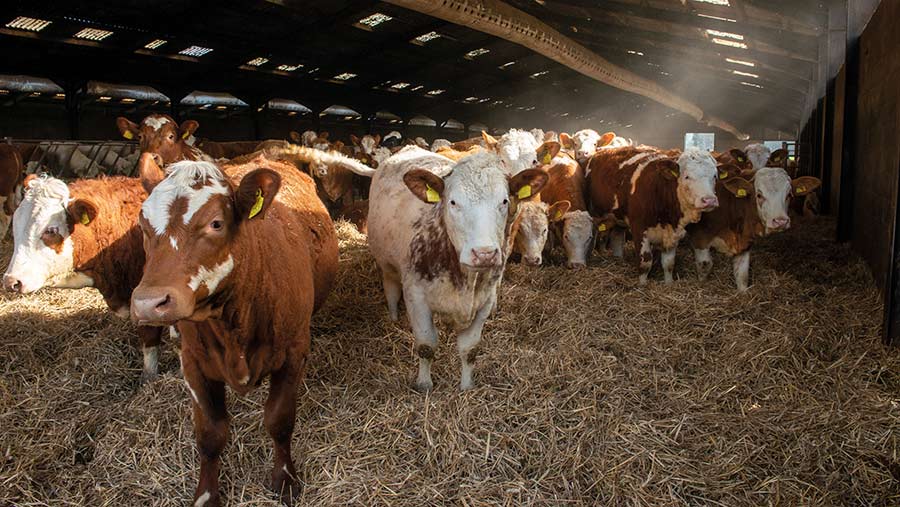 © Angus Findlay
© Angus Findlay Focusing on three key efficiency measures has ensured the pedigree suckler cow and bull beef enterprises at Strathisla Farms, Perthshire, have remained commercially viable.
The cattle have made a profit without subsidy, and broken even before pedigree sales, says farm manager Adrian Ivory.
Data is at the heart of this success, although running a large arable operation alongside the cows brings a major advantage in labour and machinery sharing.
And pedigree sales through Strathisla Simmentals and Cardean Charolais add a valuable income stream.
See also: 10 ways one farm makes suckler beef profitable
Strathisla Farms
- 60 pedigree Simmentals
- 155 commercial suckler cows (Simmental cross Shorthorn)
- 40 pedigree Charolais
- 164ha (405 acres) grassland
- 580ha (1,433 acres) of cereals, with 337ha (833 acres) in profit-sharing partnership
- Grass rotation is four years of grass, spring barley and winter barley
- Five full-time labour units (including Adrian Ivory)
- Beef sold to ABP, Perth, for Asda; heifers sold as stores
- Pedigree stock sold privately and at Stirling Market
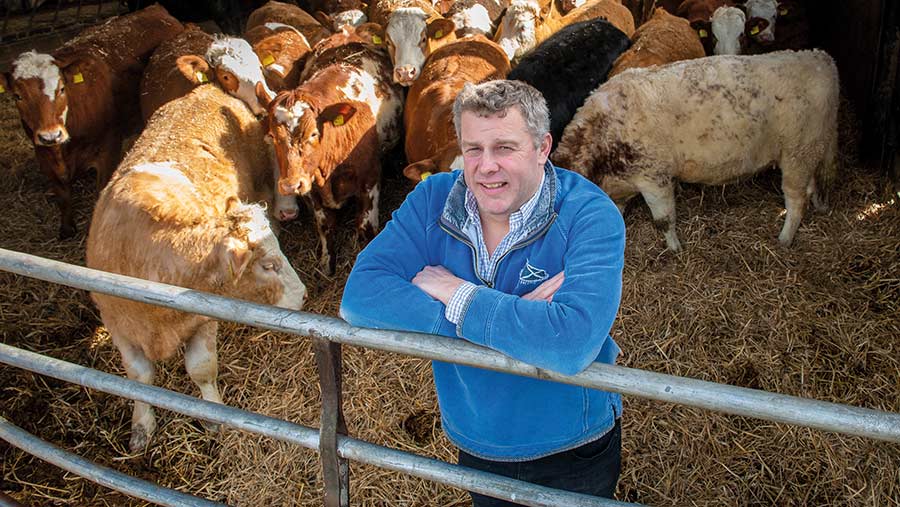
Farm manager Adrian Ivory © Angus Findlay
Data-driven
A booklet is produced annually on the breeding, feeding, fertility, temperament, grading, saleability and calving of the herd and individuals.
“Recording helps us identify and address issues,” says Mr Ivory, who has farmed at Islabank Farm, Meigle, since 1998. Data is recorded on spreadsheets and through Cattle Manager.
“For example, last year we had an iodine issue in some cows. We found out because conception rate dropped from 88% to 82%.”
Farm accounts for 2021
- Rough management accounts for 255 head (all pure and commercial cows)
- Wages for two full-time staff shared with arable unit (80% of the wages on cattle)
- Costs are “cash costs”, in other words depreciation is not given (repairs and servicing = £11,000, building repairs and fencing = £1,000)
- Home-grown barley valued at average market price and sold to cattle after harvest (£135/t)
- Vet spend was £58 a cow
- Bought-in feed (barley, draff, potatoes, minerals) costs were £383 a cow (£466 a cow with fertiliser/contractor costs)
- No cost for bedding (muck-for-straw agreement with arable)
- Pedigree costs = £86 a cow (shows/sale advertising, health scheme, pedigree registrations and semen)
Profit a cow (2019-21) |
|||
|
Profit |
2019 |
2020 |
2021 |
|
A cow without subsidy |
£36.26 |
£39.46 |
£79.83 |
|
Including Scottish Suckler Beef Support Scheme |
£125.10 |
£154.83 |
£166.72 |
|
Note: Profit margin does not include any Basic Payment Scheme payment |
|||
Every year’s figures are discussed with the farm adviser, accountant, vets and all the staff in a big meeting.
Mr Ivory says monitoring three metrics (see below) has had the biggest effect on performance and profitability in recent years.
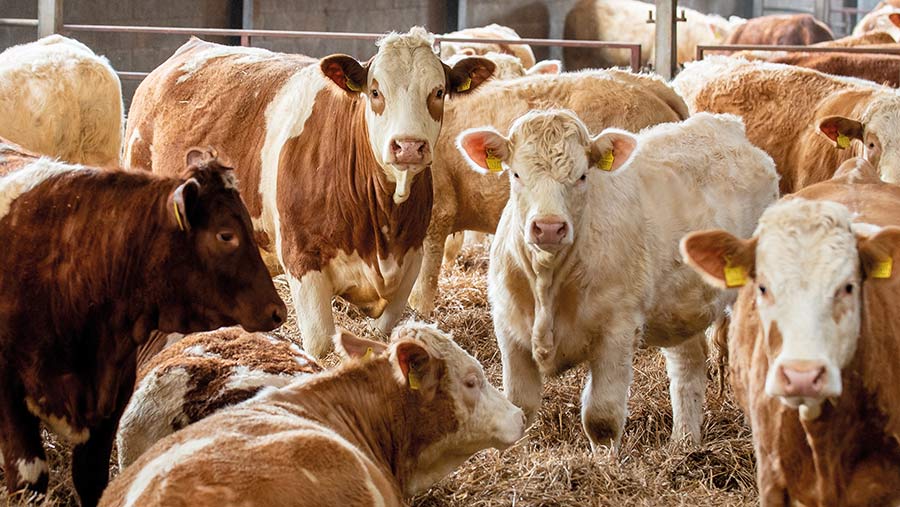
© Angus Findlay
1. Days to calving
- What it is A herd and cow average of the number of days between one calving and the next.
- Why it matters Cows must produce a calf each year and customers must get fertile stock. All cows are expected to hold to the bull within 10-11 weeks, wean at 200 days on average and, ideally, produce six or seven calves in their lifetime. Herd replacement rate is about 15%.
- What it can tell you Loss in condition at grass or a difficult calving may lift days to calving for an individual. Alternatively, a nutrition issue or a sub-fertile bull may lengthen it for a group of cows. A heifer may milk off her back and produce a huge calf, but if she is struggling to get in calf, she is of little use.
- How it is analysed The aim is to average 365 days to calving, which some cows do (range was 335-430 days last year). The figure is linked to margin over feed, because the longer the cow is on feed before calving, the more it counts against her efficiency (see “Margin over feed”). A cow’s days to calving is recorded and put on an individual animal report for the previous three years. If she is “slipping” consistently, she will probably be culled.
Mr Ivory says: “We don’t look at things in isolation, as each measure on its own is too crude. A consistently late calver is often better than a cow that is consistently slipping.”
Days to calving at Strathisla |
|
|
Year |
Days between calvings |
|
2016 |
371 |
|
2017 |
378 |
|
2018 |
375 |
|
2019 |
375 |
|
2020 |
370 |
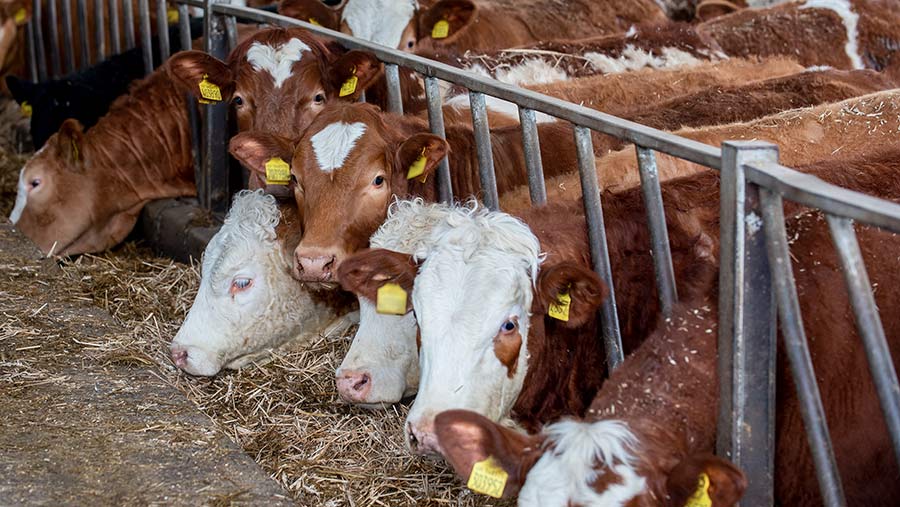
© Angus Findlay
2. Days to slaughter
- What it is The number of days from electronic identification tagging at birth to the animal leaving for the abattoir.
- Why it matters At a rough figure of £2.50/day, the extra 23 days on feed in 2016 compared with 2021 could equate to £57.50 a head (see “Days to slaughter for all bulls at Strathisla”).
- What it can tell you How diet, breed, sire and cow families are working. It can also enable selection for the strongest, best-fed calves that grew well all their life.
- How it is analysed This is broken down by sire and dam to see if there is a genetic reason why performance has slipped. It can be combined with daily liveweight gain to look at the best and worst animals on feed.
Mr Ivory says: “We find legal definitions on prime young bulls at a minimum of 12 months is hampering efficiency. Six or seven years ago we first managed slaughter weight at 11 months of age. Today we could probably do that with 20-25%.”
Days to slaughter for all bulls at Strathisla |
||
|
Year |
Days to slaughter |
Simmental/Charolais |
|
2016 |
430 |
420/428 |
|
2017 |
411 |
403/405 |
|
2018 |
429 |
409/435 |
|
2019 |
413 |
404/430 |
|
2020 |
415 |
403/422 |
|
2021 |
407 |
401/404 |
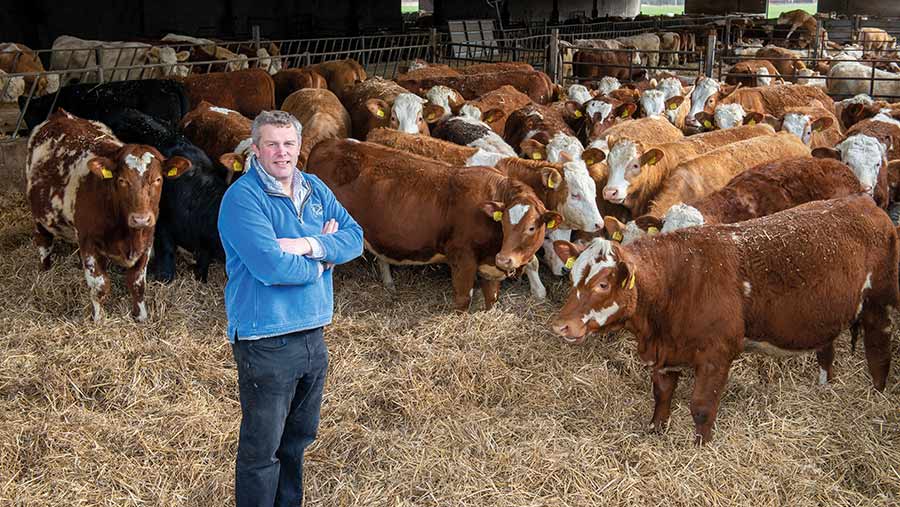
© Angus Findlay
3. Margin over feed
- What is it The margin left after an average cow’s feed cost has been deducted from an average progeny value across the marketing period (to account for market fluctuations). An average cow diet is 13.42kg dry matter a head a day. On a freshweight basis this is 26kg silage, 3kg straw, 1kg barley, 1kg dark grains and 125g minerals. This was developed with Robert Gilchrist when he was a knowledge transfer specialist at Quality Meat Scotland.
- Why it matters Margin over feed (MOF) gives a rough idea of a cow’s feed efficiency. The dry cow diet costs £1.49/day and the winter period is six or seven months, so feed costs are high. However, 50 of the cows in the best condition at pregnancy diagnosis have been outwintered on stubbles for the past two years to minimise winter costs.
- What it can tell you It shows cows producing low-value offspring. It can be correlated with cow efficiency to see if it is also an issue at weaning time. Heifers can be kept from the best-performing cows to breed for efficient animals.
- How it’s analysed Cows in the bottom third tend to stay there. Checked alongside cow weight and age, it can be used to cull big cows that wean small calves. Weaning percentage is calibrated at 200 days, and this figure is looked at alongside MOF to work out cow efficiency.
MOF performance at Strathisla |
||
|
Year |
Top MOF (£) |
Average MOF (£) |
|
2017 |
1,069 |
903 |
|
2018 |
1,040 |
840 |
|
2019 |
982 |
805 |
|
2020 |
990 |
841 |
|
2021 |
1,208 |
974 |
